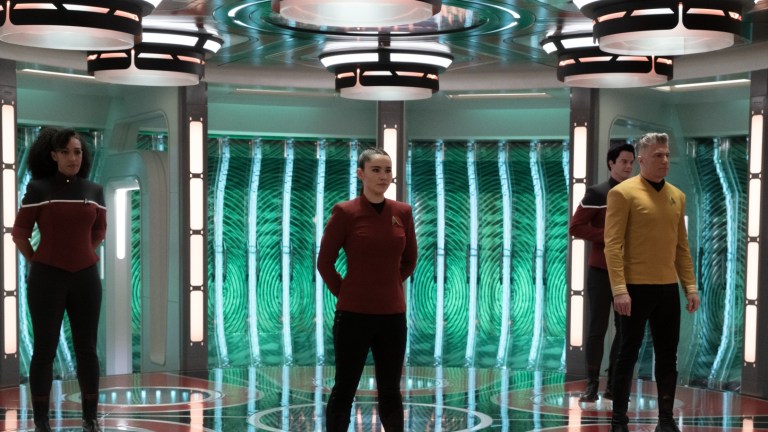Star Trek Characters Die in the Transporter All the Time. Why Are They Okay With It?
Star Trek's transporters are convenient but deadly, suggesting something surprising about the franchise's take on the human soul.

“Beam me up, Scotty” is a quote as iconic as Star Trek‘s once-magical automatic doors ― even if Captain Kirk didn’t actually say it. While Star Trek wasn’t the first sci-fi creation to teleport its characters around, its pleasingly sparkly transport scenes quickly captured fans’ imaginations. However, what is beamed up isn’t necessarily what is beamed down.
Simply put, Star Trek transporters, if they were real, would kill their users along the way. No matter the technicalities over moving versus duplicating the bits that make up a Trek crewman, you cannot blast a person into atoms without ending their brain functions and destroying them. You just can’t. Try it (don’t try it). So depending on how lazy a character is, a commute from a starship bridge to the bathroom could be the last thing they ever do.
It’s something that’s fascinated and vexed overthinkers in the fandom through the decades, with YouTuber CGP Grey among those warning of the “real” nature of starships’ transporters (and validating The Next Generation’s Reg Barclay’s fear of them).
Despite this, it’s mostly unremarked upon in the show ― even when Captain Picard, in The Next Generation episode “Lonely Among Us,” basically dies in space, with the transporter used to make him a new body for his untethered “energy” to enter. “What the devil am I doing here?” he asks when he reappears. He’s clearly not quite the same man.
Picard’s crew might not care who exactly it is that they’ve beamed back to the Enterprise. But the bait-and-switch of the transporter haunts pop culture consciousness, just as countless versions of crewmen might haunt their starships. One example is China Mieville’s fantasy novel Kraken, in which a Trekkie uses magic to make a transporter, only to end up stalked by dozens of iterations of his own ghost. Author Jason Pargin, too, muses over the horrific implications of transportation in This Book is Full of Spiders.
Mieville and Pargin appear to imply that Star Trek characters don’t know transportation kills them. But Trek‘s crewmen have scientific training and live in a world that encourages philosophical thinking. If Kirk, Picard, and co. all know that transporters are deadly, why are they happy to use them?
You could argue that we all need a sense of being whole and individual beings, experiencing life as one unbroken continuity, for the world to function. For Star Trek characters to live as they do, lives made infinitely easier by utopian tech, perhaps ignoring their many deaths is a bargain that has to be made.
This would make a starship crewman a kind of cloned pretender. That angle has certainly cropped up in episodes over the decades. In The Original Series episode “The Enemy Within,” a transporter accident creates two Captain Kirks (one comically evil, of course ― though unlike Evil Spock he regrettably doesn’t sport a goatee). Both are different men from the original Kirk, so at the end he is not so much brought back as made whole again. And the fact that the transporter can create two Will Rikers from one in TNG episode “Second Chances” also shows some kind of replication is at play.
Another take would be that Star Trek characters aren’t invested in an illusion at all, but are actually pretending less than we are. Freed from constraints of space and time by starships, freed from the production and ownership of objects by replicators, the next thing to go is the permanent self.
Psychoanalyst Jacques Lacan wrote that when a human first recognizes their reflection as their self, they enter an imaginary world mediated by language. This abstraction or layer of removal from the self might be how you live if you’re just one in a long line of yous. Philosopher Jean Baudrillard took the idea of reality as a kind of shared dream further, arguing we live in “hyper-reality,” a set of representations more real than the now-dead aspects of the world they reference. Are starship crewmen hyper-real people? Made anew, carrying more thoughts and experiences than the first version of themselves to die?
Perhaps they have decided to ditch the whole game of pretending humans consist of a structurally sound self that remains one thing. After all, our cells are always renewing, our neurons changing. Consciousness is just one of many functions our brains undertake, and we can experience breaks in it, like the breaks transporters would cause. We are not even each one body, with so much of our mass made up of micro-organisms which have no clue that the city they are part of is a sentient being.
This angle would mean Star Trek characters are living in the aftermath of a huge historical and psychological rupture caused by transport tech. They have a whole different view of what it is to be a person. To them, living a life includes many endings and beginnings, via a multitude of consciousnesses.
A case in point: in Voyager episode “Tuvix,” another transporter accident happens. This time, instead of creating two people, it makes a hybrid of Tuvok and Neelix, with an unsettling combination of Vulcan eyebrows and already-nightmarish Talaxian sideburns. After some conflict over ethics, Tuvix is eventually sacrificed.
Tuvix is his own person, and Tuvok and Neelix have died by at least some definitions when they merged to create him. But for Voyager‘s Captain Janeway, Tuvix’s death is seen as necessary so that Tuvok and Neelix’s consciousnesses can continue where they left off. Plus, when the pair of men return, Janeway sees them as the real deal. “It’s good to have you back,” she tells them.
Star Trek characters’ selves, then, are based on carrying memories and a personality, passing it from one body to another, rather than possessing an unbroken consciousness. So what if traveling from point A to point B means a person being consigned to the void, no thoughts assailing them ever again? Their journey through time and space continues anyway, like a relay race. Each body, in Star Trek, is a tiny part of the story of a person. They get to live for a day or a week while building the ambitions that the next them will take forward, and experiencing the memories and personality of their countless ghosts.
Maybe you’d die if you stepped into a Star Trek transporter. But the group project you contributed to, the project called You, would boldly go on ― into experiences no less real for your multitude.
